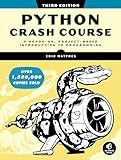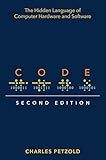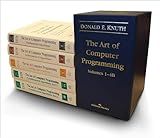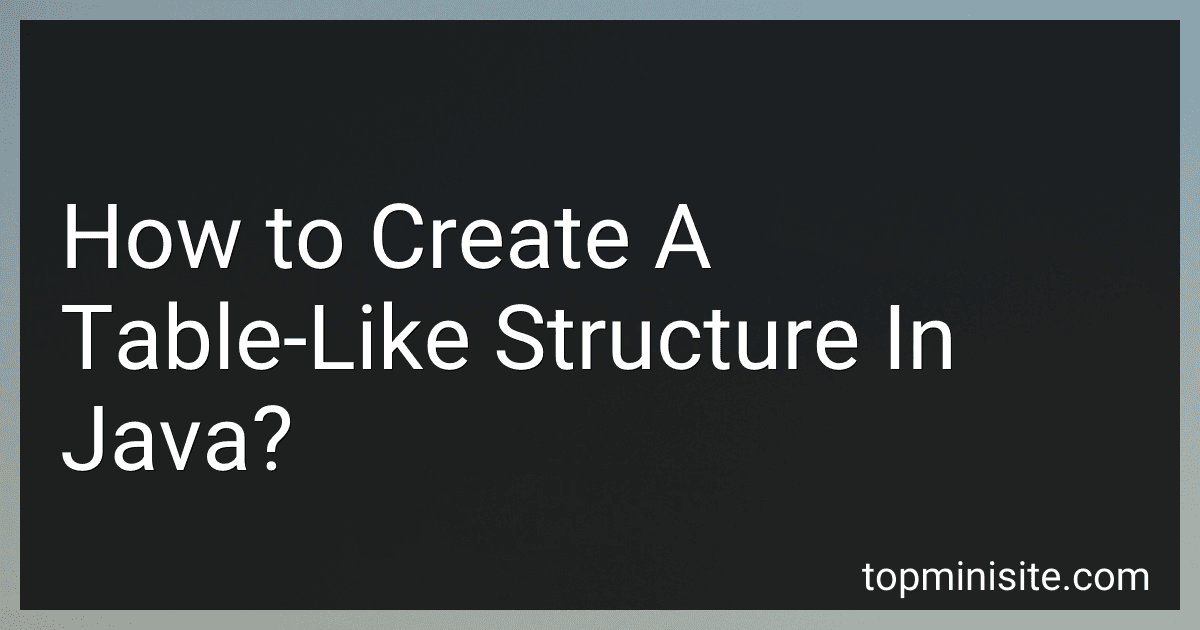Best Programming Books to Buy in December 2025

Beginner's Step-by-Step Coding Course: Learn Computer Programming the Easy Way (DK Complete Courses)



Python Crash Course, 3rd Edition: A Hands-On, Project-Based Introduction to Programming



Everything You Need to Ace Computer Science and Coding in One Big Fat Notebook: The Complete Middle School Study Guide (Big Fat Notebooks)



Code: The Hidden Language of Computer Hardware and Software



Cracking the Coding Interview: 189 Programming Questions and Solutions
- EASY-TO-READ FORMAT BOOSTS COMPREHENSION FOR QUICK LEARNING.
- COMPACT DESIGN PERFECT FOR ON-THE-GO READING AND STUDYING.
- GOOD CONDITION ENSURES QUALITY CONTENT AT AN AFFORDABLE PRICE.



The Pragmatic Programmer: Your Journey To Mastery, 20th Anniversary Edition (2nd Edition)



Clean Code: A Handbook of Agile Software Craftsmanship (Robert C. Martin Series)



Art of Computer Programming, The, Volumes 1-4B, Boxed Set


In Java, you can create a table-like structure using various techniques. One common approach is to use multidimensional arrays or nested lists to represent rows and columns in the table.
To begin, you can declare and initialize a multidimensional array using the following syntax:
dataType[][] arrayName = new dataType[numberOfRows][numberOfColumns];
For example, if you want to create a table with 3 rows and 4 columns to store integers, you can do it like this:
int[][] table = new int[3][4];
To access or modify individual elements in the table, you can use indices:
table[rowIndex][columnIndex] = value; // Setting a value
int element = table[rowIndex][columnIndex]; // Getting a value
Another way to create a table-like structure is by using nested lists. You can use the ArrayList class in Java to create lists within lists. Here's an example:
import java.util.ArrayList;
ArrayList<ArrayList> table = new ArrayList<>();
// Adding a row ArrayList row1 = new ArrayList<>(); row1.add(value1); row1.add(value2); table.add(row1);
// Accessing a value dataType element = table.get(rowIndex).get(columnIndex);
// Modifying a value table.get(rowIndex).set(columnIndex, newValue);
These are just two basic examples of creating a table-like structure in Java. Depending on your specific requirements, you can explore more advanced techniques such as using custom classes to represent rows and columns, or even using external libraries that provide table functionalities.
How can you represent a table-like structure using arrays in Java?
In Java, you can represent a table-like structure using arrays by using a 2-dimensional array. Here's an example of how it can be done:
// Initializing a 2-dimensional array int[][] table = new int[rows][columns];
// Accessing elements in the table table[row][column] = value;
// Iterating over the table for (int row = 0; row < rows; row++) { for (int col = 0; col < columns; col++) { // Accessing and manipulating elements in the table int value = table[row][col]; // Perform operations on the value } }
In this example, table is a 2-dimensional array of int type. The first dimension represents the rows, and the second dimension represents the columns of the table. The size of the array can be defined by specifying the number of rows and columns when initializing the array.
You can access and assign values to individual cells in the table using the row and column indices. For example, table[0][1] accesses the element in the first row and second column of the table.
To iterate over the entire table, you can use nested for loops to iterate over the rows and columns, respectively. This allows you to access and manipulate each element individually.
What are the common operations performed on a table-like structure in Java?
The common operations performed on a table-like structure in Java include:
- Inserting data: Adding new rows or records to the table.
- Retrieving data: Fetching rows or records from the table based on specific criteria.
- Updating data: Modifying values in one or more columns for existing rows.
- Deleting data: Removing rows or records from the table.
- Sorting data: Reordering rows or records based on a specific column or columns.
- Filtering data: Selecting only specific rows or records based on certain conditions.
- Joining tables: Combining rows or records from multiple tables based on common data.
- Aggregating data: Calculating summary values like count, sum, average, etc., for one or more columns.
- Indexing: Optimizing data retrieval by creating indexes on specific columns to speed up queries.
- Transacting data: Ensuring atomic and consistent operations by using transactions.
- Validating data: Enforcing constraints and ensuring data integrity by performing validations.
- Modifying schema: Altering the structure of the table, such as adding, modifying, or removing columns.
- Table operations: Creating, dropping, or renaming tables.
- Schema operations: Creating, dropping, or modifying the database schema.
- Querying: Executing SQL queries to retrieve data based on specific criteria.
Can you provide an example of creating a table-like structure using LinkedList in Java?
Certainly! Here's an example of creating a table-like structure using LinkedList in Java:
import java.util.LinkedList;
public class TableExample {
public static void main(String\[\] args) {
LinkedList<LinkedList<String>> table = new LinkedList<>();
// Creating rows of table using LinkedList
LinkedList<String> row1 = new LinkedList<>();
row1.add("Name");
row1.add("Age");
row1.add("City");
LinkedList<String> row2 = new LinkedList<>();
row2.add("John");
row2.add("25");
row2.add("New York");
LinkedList<String> row3 = new LinkedList<>();
row3.add("Emily");
row3.add("30");
row3.add("London");
// Adding rows to the table
table.add(row1);
table.add(row2);
table.add(row3);
// Displaying the table
displayTable(table);
}
public static void displayTable(LinkedList<LinkedList<String>> table) {
for (LinkedList<String> row : table) {
for (String column : row) {
System.out.print(column + "\\t");
}
System.out.println();
}
}
}
In this example, we create a LinkedList called table to store the rows of our table. Each row is represented by another LinkedList. We create three rows (LinkedLists) with different values and add them to the table LinkedList.
To display the table, we define a method displayTable that takes the table LinkedList as an argument. It uses nested loops to iterate over each row and each column, printing out the values.
When running the main method, it will produce the following output:
Name Age City
John 25 New York
Emily 30 London
Here, we have successfully created a table-like structure using LinkedList in Java.
Is it possible to create a resizable table-like structure with a fixed number of columns in Java?
Yes, it is possible to create a resizable table-like structure with a fixed number of columns in Java using various data structures and classes available in the Java programming language.
One way to achieve this is by using a combination of an ArrayList of ArrayLists, where the outer ArrayList represents each row and the inner ArrayList represents each column in a row.
Here is an example code snippet demonstrating how to create a resizable table-like structure with a fixed number of columns:
import java.util.ArrayList;
public class ResizableTable {
private ArrayList<ArrayList<Object>> table;
private int columns;
public ResizableTable(int columns) {
this.columns = columns;
table = new ArrayList<>();
}
public void addRow(ArrayList<Object> row) {
if (row.size() != columns) {
throw new IllegalArgumentException("Incorrect number of columns");
}
table.add(row);
}
public void printTable() {
for (ArrayList<Object> row : table) {
for (Object item : row) {
System.out.print(item.toString() + " ");
}
System.out.println();
}
}
public static void main(String\[\] args) {
ResizableTable rt = new ResizableTable(3);
ArrayList<Object> row1 = new ArrayList<>();
row1.add("John");
row1.add(25);
row1.add(100.0);
rt.addRow(row1);
ArrayList<Object> row2 = new ArrayList<>();
row2.add("Jane");
row2.add(30);
row2.add(150.0);
rt.addRow(row2);
rt.printTable();
}
}
In the above example, the ResizableTable class represents the resizable table-like structure. The addRow() method is used to add a new row to the table while checking for the correct number of columns. The printTable() method is used to print the contents of the table.
In the main() method, a ResizableTable object rt is created with 3 columns. Two rows are then added to the table using addRow() method, and finally, the table is printed using printTable() method.
